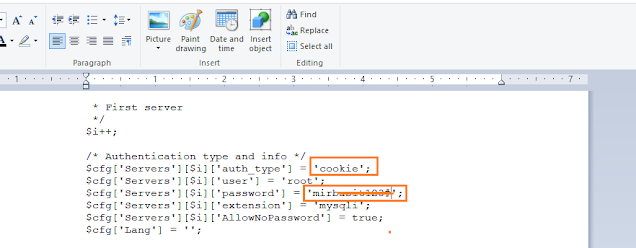
The file to edit to add this text for /security and /webalizer is c:\xampp\apache\conf\extra\nf.
Xampp mysql password password#
To protect these folders with the same password that you have for the /xampp folder, you need to add some text just before the directives in your Apache config files for each folder, as shown in red below: Alias /web_folder_name "C:/xampp/ foldername"ĪuthUserFile C:\\xampp\\security\\ers You can use the same username/password that you chose for the XAMPP pages, which is stored in the c:\xampp\security\ers file. You may also want to password protect other XAMPP pages that you have chosen to keep. If you want to keep the webalizer and security pages of XAMPP, I suggest that you password protect them. Password protect /webalizer, /security, and any other XAMPP folders that you decided to keep When you stop MySQL this way, the XAMPP control panel will reflect that it is stopped. To stop MySQL, you’ll need to open a command window (Start->Run “cmd”), and execute c:\xampp\mysql_stop.bat. You can still use it to start MySQL, but stopping it via the control panel will fail. Consequence to using XAMPP control panel if pma password is changedĪfter you change your pma password, it seems that you are no longer able to use the XAMPP control panel to stop MySQL. If you get an error when you try to sign on, which says this: “#1045 – Access denied for user (using password: NO)”, it means that you didn’t put the correct password into the file. Exit phpmyadmin (click this button:, which is at the top of the left sidebar), and try to sign in again first as “root” and then as “pma”. It is a good idea to check if you have done this properly. Now you are finished setting the password for “pma”. You need to add your pma password to this file (shown in red below) mysql\\bin\\mysqladmin -user=pma -password= password shutdown By default, this file has this on the 3rd line: mysql\\bin\\mysqladmin -user=pma -password= shutdown This is in the file c:\xampp\mysql_stop.bat. There is one other place where you need to enter in your pma password. Find this line: $cfg = '' // access to the "mysql/user"Īnd place the password between the two ‘ on the right side of the “=”: $cfg = ' password' // access to the "mysql/user" Open the file c:\xampp\phpmyadmin\ in your favorite text editor. Now we need to let the phpMyAdmin config file know what the password is so that phpMyAdmin will continue to work. Type in the old and new passwords and click on “Go” just underneath where you entered these passwords. I suggest using a password that is different than the phpMyAdmin password.

First, you change the password using phpMyAdmin, and then you need to edit the file to let phpMyAdmin know what the password is. There are 2 steps involved in changing the password for “pma”. This should be changed to increase your security. You should have already given a password to the “root” user, but the “pma” user still has a blank password. The “pma” user is used by the phpMyAdmin application. Change the password of the “pma” user in phpMyAdminīy default, the MySQL database provided by XAMPP contains 2 users, “root” and “pma”. There are more folders and users that should be protected. The XAMPP built-in security only gives password protection to phpMyAdmin root user and to the /xampp folder.

See the overview page for all the security measures.
Xampp mysql password series#
This article is part of a series of articles about making XAMPP more secure.


 0 kommentar(er)
0 kommentar(er)
